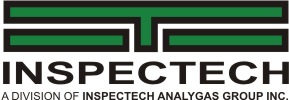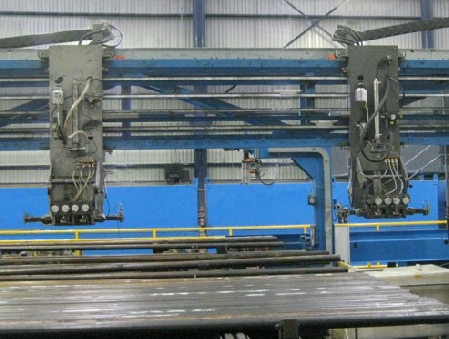



A Division of InspecTech Analygas Group Inc.
450 Midwest Road, Toronto, Ontario, Canada, M1P 3A9
Tel: 416-
A Time When Two Heads Really Are Better Than One.
In 2008 we completed an off-
system for API tubular goods and
commissioned it in the customer's facility.
As is the case with all InspecTech off-
U/T systems, it covers 100% of the weld
zone, meaning that there are no untested
ends on the tubes that must be later
re-
In this case, the test head approaches the
pipe end and the first pair of probes mount
the pipe. The test head stops with the
probes just on the end of the pipe until
coupling is gained, then the head
advances very slowly until the second
pair have mounted the pipe end, and the
coupling process is repeated. Only when
both probe pairs are engaged at the pipe
end and fully coupled, does the test head
move at full speed over the rest of the
pipe, thus testing right up to the far end.

In late 2009, we were asked to quote for a second such system, as the mill production was expected to increase and the NDT was a potential bottleneck.
It occurred to us that a second system would involve our customer in some very expensive
(and time-
The overall time needed to test a welded pipe is in part the time required to get proper coupling over the end, and in part the time to run the high speed test. These times were nearly equal in our existing system, meaning that a second complete test system could nearly double the productivity, but a second test head on the same system could only reduce the running time, not the end testing time, which would be a very minor improvement in productivity.
However, we reasoned that a test head that is dedicated to testing just the end zone plus a few feet of pipe, when operated with a second test head that tests the majority of the pipe length, could be a significant improvement.
The difficulty with this plan was due to the fact that the system tested one pipe from left to right and the next pipe from right to left. This meant that the two test heads would be required to reverse roles between tests. This posed a number of challenges in the software and PLC programming areas, but in the end; along with some adjustments to the pipe handling routine, we succeeded in very nearly doubling the throughput of the original system by adding a second test head to the existing track..
We are very pleased with this result; it means our customer enjoys nearly twice the productivity at a fraction of the cost of a second complete system.
Robert (Bob) Fowlds
At the end of May 2010, InspecTech lost an old friend and a 14 year veteran of the Company. Bob Fowlds passed away in Oshawa Ontario.
Bob had been part of InspecTech at the very beginning in 1977, and he had returned to us in 1996 to run our mechanical shop. Bob's knowledge of machine shop practice was encyclopaedic, and our product quality flourished under his guidance.
Over the years, Bob had built solid relationships with our suppliers and sub contractors.
Bob leaves his wife Betty, his son Alan and daughter Jennifer, plus 4 grandchildren. Bob will be missed by us all in the months and years to come.





Calibration Defects; Have You Ever Wondered?
Some people calibrate their test systems on drilled holes and others use machined notches. Why the difference?
Obviously, it depends upon code requirements, but aside from that you will usually find eddy current testers being set up on drilled holes while ultrasonic users depend upon machined notches.
The reason of course is quite simple. Eddy current machines are very sensitive to holes, less so to notches; whereas ultrasonic systems respond very well to notches but less well to holes.
Codes of practice are starting to acknowledge this fact. Recent revisions to API require manufacturers to demonstrate detection of longitudinal inside notches: not easy with eddy current methods. Conversely, the size of drilled hole has been reduced for U/T users.
Flux leakage testing, as a matter of interest, is equally adept at both types of defect.
